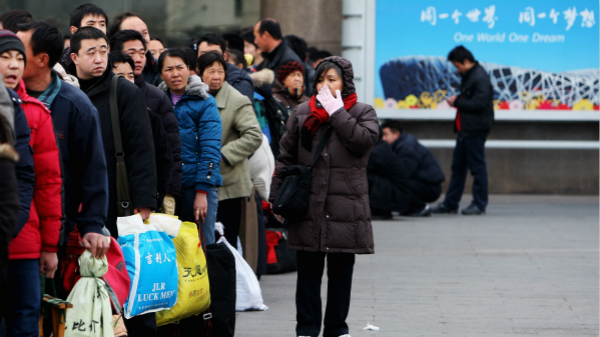实行计划经济的国家不仅试图控制产业“制高点”,还试图控制本国人民的流动。中国转变成如今的经济强国,是在国人被准许离开只够维持温饱的农田、进入工厂和城市之后才实现的。
Planned economies attempt to control not only the “commanding heights” of industry, but also the movement of their people. The transformation of China’s economy into the powerhouse it is today came about only after Chinese were allowed to leave subsistence farms for factories and cities.
过去几周中国发生的两大事件表明,在这个世界最大的经济体,尽管市场力量很强大,规划者们想要引导人口流动和劳动力的本能仍没有消失。
Two big developments in China in the last few weeks show that the planners’ instinct to channel population flows and the labour force has not disappeared, despite the power of market forces in the world’s largest economy.
苹果(Apple)的主要代工商富士康(Foxconn)最近宣布,将“立即采取行动”停止让学生加班生产iPhone X的做法,英国《金融时报》此前的一项调查曝光了富士康位于中国内陆城市郑州的一家大型工厂的这一行为。
Apple’s primary manufacturer Foxconn last week announced it would take “immediate action” to stop students working overtime to produce the iPhone X after a Financial Times investigation revealed the practice in its vast factory in the interior city of Zhengzhou.
这种事情不是第一次发生。五年前就出现过几乎同样的一幕:富士康因在郑州等地的工厂使用学生加班生产iPhone 5而受到指责。在这两起事件中,为了赶在圣诞节前将苹果热销的新产品送上货架,富士康需要廉价且愿意加班的劳动力。
This is not the first time this has happened. Five years ago, under nearly identical circumstances, Foxconn was criticised for pulling in students to work overtime at Zhengzhou and other plants to produce the iPhone 5. In both cases, cheap overtime labour was needed to get Apple’s hot new product into stores before Christmas.
富士康之所以在郑州开设工厂,部分原因是河南省政府承诺让其工资成本保持在较低水平。但没人想到,工人们大多都去了工资更高的地方。当富士康等制造商骤然需要达到生产峰值时,中国内陆地区较低的工资水平无法吸引到足够多的临时劳动力。幸运的是,这些企业可以从职业技术学校招人,那里是低成本劳动力的集中地。学生拿的工资低于成年劳动力。此外,企业无需支付高昂遣散费就可以让学生们返回“学校”,因为他们不是正式“雇员”。
Foxconn opened the Zhengzhou plant in part because the Henan provincial government promised lower wage costs. No-one considered that workers had already left for places where wages are higher. When Foxconn and other manufacturers require sudden production peaks inland China’s lower wages do not attract enough temporary workers. Luckily for the companies, they can turn to the vocational technology schools, which function as concentrated pools of low-cost labour. Students can be paid less than the adult workforce. Moreover, students can be returned to “school” without an expensive lay-off process, since they were never formally “employees”.
如果学生们拒绝在装配线上积累“工作经验”,学校可以不发给他们毕业证书。无法毕业就白白浪费了学费,花钱供子女上学的父母希望有张文凭孩子能找到比装配线岗位更好的工作。对于那些已经因在残酷的高中或大学入学考试中落榜而令家人失望的青少年学生而言,这是一个确实有效的威胁。
If students refuse “work experience” on assembly lines, schools can withhold graduation certificates. Not graduating would be a terrible waste of tuition paid by parents hoping the qualification will put their children in better jobs than assembly line work. It is a credible threat for teenagers who have already disappointed family hopes by failing tough high school or college entrance exams.
实际上,虽然人口结构变化本应推高中国制造的成本,但职业技术学校使得中国可以在更长时间内将制造业工资维持在较低水平。
Essentially, the vocational technology schools allow China to keep manufacturing wages lower for longer, despite demographic shifts that would otherwise make its products more expensive.
将廉价临时劳动力从郑州等内陆制造业基地吸引走的一大转变是,中国日益繁荣的社会创造了一个充满活力的服务业。在北京、上海等富裕城市,一个生活舒适的中产家庭如今离不开保姆、送货上门的快递服务以及由穿着光鲜的侍者奉上的一杯4美元的拿铁咖啡。
One shift that has drawn cheap casual labor away from inland manufacturing bases such as Zhengzhou is that China’s growing prosperity has created a vibrant service industry. In wealthy cities like Beijing and Shanghai, a comfortable middle class now depends on nannies, rapid home deliveries and $4 lattes served by chic baristas.
欣欣向荣的服务业吸引了大批外来务工人员搬进环绕北京的廉价住宅区。还有一些人挤在昂贵公寓楼和购物中心的地下室居住。但市政府将他们视为“低端人口”,认为他们增加了交通、学校、医院等公共服务的负担。政府希望把他们清走,将北京的人口限制在2300万。
These booming services have lured an army of migrants to the slums that ring Beijing. Others cram into basement rooms underneath expensive apartment blocks and shopping malls. But the city government regards them as “low-level people” who are a drag on public services, like transportation, schools and hospitals. It wants to move them out and limit the population to 23m.
两年来,北京市提高了外来务工人员的子女入学的难度,并不停拆除廉价住房。本月,一栋拥挤不堪的建筑发生火灾,导致包括儿童在内的19人死亡。这起悲剧引发了一场对群租房的大规模清理行动,导致数万人在严冬中流离失所。此举发出的信号很明确,他们只能“回老家”。
For two years the city has made it harder for migrant children to attend school and demolished cheap housing. This month, a fire in an over-crowded building killed 19 people, including children. That tragedy triggered a massive slum clearance campaign, displacing tens of thousands into the winter cold. The idea is clearly that they will just “go home”.
但回老家能干什么?35岁以下的外出务工者大多不懂耕种,再说农地已被整合用于发展农业综合企业。
But home to where? Most migrants under the age of 35 have no idea how to farm, and anyway, the farms are being reconsolidated into agribusinesses.
中国的新计划是让大批人口离开一线城市,鼓励他们到各省较小的城市定居下来。但中国的公共资源主要集中在大城市。一般的城镇没有太多好工作,有的只是学生数量过多经费却不足的学校、条件简陋的医院,以及在内陆地区被保证能获得充足廉价劳动力的从事装配业务的制造商。
Instead China’s new plan is to keep its vast population out of the biggest, wealthiest cities, and encourage them to settle in small provincial cities. But public resources are concentrated in the main cities. Provincial towns and cities do not have a surfeit of decent jobs. What they have is over-crowded, underfunded schools and sub-standard hospitals — and assembly-line manufacturers assured of plentiful cheap labour in the hinterland.
